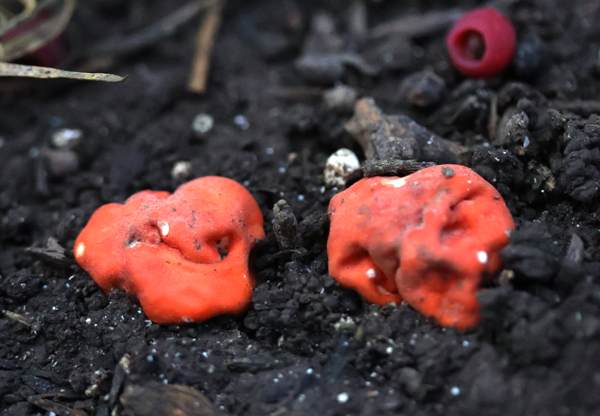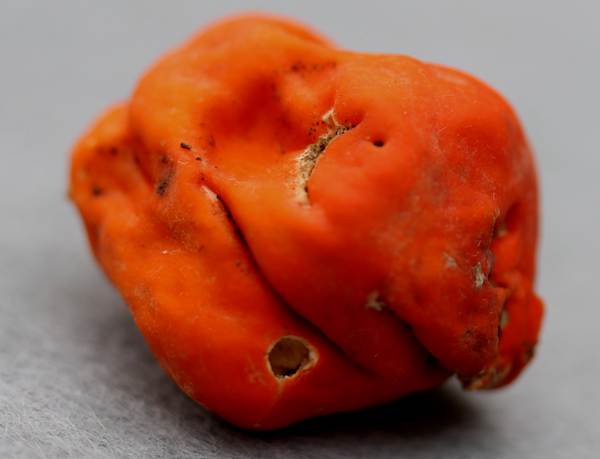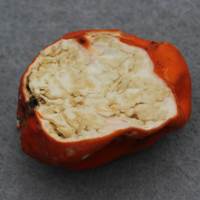Trees Birds Mammals Fish Amphibians Reptiles
Wild Algarve
Bookshop
Paurocotylis pila Berk. - Scarlet Berry Truffle
Phylum: Ascomycota - Class: Pezizomycetes - Order: Pezizales - Family: Pyronemataceae
Distribution - Taxonomic History - Etymology - Identification - Culinary Notes - Reference Sources

Paurocotylis pila, referred to as the Scarlet Berry Truffle in the British Mycological Society's list of English names for fungi, is also known as the New Zealand Truffle because, while an introduced species in Britain and Europe, it is native to New Zealand and parts of Australia.

The striking colour of these truffle-like ascomycete fungi makes them very easy to separate from other truffle-like fungi found in Britain and Europe.
Distribution
First recorded in Britain in 1973 from a disused gravel pit in Nottinghamshire, this species appears to be spreading. There are now records from England, Ireland, Scotland (with many sightings on Orkney) and Wales. It has been suggested that the dispersal of this species can best be explained by the spore mass being eaten and later excreted by birds. Of the few dozen recorded specimens in Britain and Ireland, many are reported to have holes apparently pecked by birds.
Taxonomic history
When in 1885 the British mycologist Rev. Miles Joseph Berkeley described this species he gave it the scientific name Paurocotylis pila, by which name it is still known today.
Etymology
Paurocotylis, the generic name, comes from Greek , pauro- meaning few and -cotylis means cavity. This may be a reference to the structure of the interior of these truffle-lik fungi. The specific epithet pila is the Latin word for a vertical supporting structure such as a pillar or a pier; however, in this context it is more likely used to mean a sphere - referring to the general shape of the fruitbodies.
Identification guide
 |
Fruitbody
Typically 2 to 5cm across but occasionally larger, the fruitbodies are irregularly spherical and often have shallow sinuations (surface wrinkles) on a soft smooth peridium, The outer surface is bright red to orange or apricot. There is no stipe.
Inside, the spore-bearing material is veined and contains many folds and some small cavities. It is initially white, becoming creamy yellow as the spore mass matures. |
| |
Spores
Globose, 18 - 20 µm in diameter.
Spore mass
Yellowish cream |
Habitat & Ecological role |
Often found in leaf litter, particularly under Rowan trees, but also beside compacted paths and sometimes in gardens and parks. |
Season |
Autumn and winter. |
Similar species |
The Piedmont White Truffle Tuber magnatum has a creamy brown smooth exterior and a cream or ochre interior. |
Culinary Notes
These rare (in Britain, at least) fungi are not considered edible.
Reference Sources
Hobart, C. (2019). Paurocotylis pila is still spreading across Britain: some thoughts In Field Mycology Vol. 20 (1) BMS
Eggerling, TW (2004). Paurocotylis pila In Field Mycology Vol. 5 (2) BMS
Dennis, R.W.G. (1981). British Ascomycetes; Lubrecht & Cramer; ISBN: 3768205525.
Breitenbach, J. & Kränzlin, F. (1984). Fungi of Switzerland. Volume 1: Ascomycetes. Verlag Mykologia: Luzern, Switzerland.
Medardi, G. (2006). Ascomiceti d'Italia. Centro Studi Micologici: Trento.
Dictionary of the Fungi; Paul M. Kirk, Paul F. Cannon, David W. Minter and J. A. Stalpers; CABI, 2008
Taxonomic history and synonym information on these pages is drawn from many sources but in particular from the British Mycological Society's GB Checklist of Fungi.
Acknowledgements
This page includes pictures kindly contributed by David Lawman.
Top of page...
Fascinated by Fungi. Back by popular demand, Pat O'Reilly's best-selling 450-page hardback book is available now. The latest second edition was republished with a sparkling new cover design in September 2022 by Coch-y-Bonddu Books. Full details and copies are available from the publisher's online bookshop...